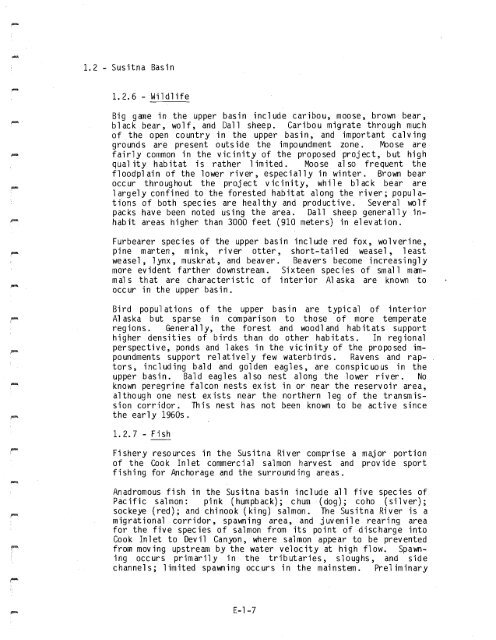before the ferc, application - Alaska Resources Library
before the ferc, application - Alaska Resources Library
before the ferc, application - Alaska Resources Library
Create successful ePaper yourself
Turn your PDF publications into a flip-book with our unique Google optimized e-Paper software.
-<br />
-<br />
-<br />
,....<br />
......<br />
....<br />
I<br />
-<br />
-<br />
-<br />
1.2 - Susitna Basin<br />
1.2.6 - Wildlife<br />
Big gcrne in <strong>the</strong> upper basin include caribou, moose, brown bear,<br />
black bear, wolf, and Dall sheep. Caribou migrate through much<br />
of <strong>the</strong> open country in <strong>the</strong> upper basin, and important calving<br />
grounds are present outs ide <strong>the</strong> impoundment zone. Moose are<br />
fairly cornmon in <strong>the</strong> vicinity of <strong>the</strong> proposed project, but high<br />
qual ity habitat is ra<strong>the</strong>r 1imited. Moose al so frequent <strong>the</strong><br />
floodplain of <strong>the</strong> lower river, especially in winter. Brown bear<br />
occur throughout <strong>the</strong> project vicinity, while black bear are<br />
1argely confined to <strong>the</strong> forested habitat along <strong>the</strong> river; popul ations<br />
of both species are healthy and productive. Several wolf<br />
packs have been noted using <strong>the</strong> area. Dall sheep generally inhabit<br />
areas higher than 3000 feet (910 meters) in elevation.<br />
Furbearer species of <strong>the</strong> upper basin include red fox, wolverine,<br />
pine marten, mink, river otter, short-tail ed weasel, 1east<br />
weasel, lynx, muskrat, and beaver. Beavers becomeincreas'ingly<br />
more evident far<strong>the</strong>r downstream. Sixteen species of small mcrnmal<br />
s that are characteristic of interior Al aska are known to<br />
occur in <strong>the</strong> upper basin.<br />
Bird popul ations of <strong>the</strong> upper basin are typical of interior<br />
Al aska but sparse in comparison to those of more temperate<br />
regions. Generally, <strong>the</strong> forest and woodland habitats support<br />
higher densities of birds than do o<strong>the</strong>r habitats. In regional<br />
perspective, ponds and lakes in <strong>the</strong> vicinity of <strong>the</strong> proposed impoundments<br />
support rel ativel y few waterbirds. Ravens and raptors,<br />
including bald and golden eagles, are conspicuous in <strong>the</strong><br />
upper basin. Bald eagles also nest along <strong>the</strong> lower river. No<br />
known peregrine falcon nests ex ist in or near <strong>the</strong> reservoir area,<br />
although one nest exists near <strong>the</strong> nor<strong>the</strong>rn leg of <strong>the</strong> transmission<br />
corridor. This nest has not been known to be active since<br />
<strong>the</strong> early 1960s.<br />
1.2.7-Fish<br />
Fi shery resources in <strong>the</strong> Susitna River comprise a major portion<br />
of <strong>the</strong> Cook Inlet commercial salmon harvest and provide sport<br />
fishing for Anchorage and <strong>the</strong> surrounding areas.<br />
Anadromous fish in <strong>the</strong> Susitna basin include all five species of<br />
P·acific salmon: pink (humpback); chum (dog); coho (silver);<br />
sockeye (red); and chinook (king) salmon. The Susitna River is a<br />
migrational corridor, spawning area, and juvenile rearing area<br />
for <strong>the</strong> five species of salmon from its point of discharge into<br />
Cook Inlet to Devil Canyon, where salmon appear to be prevented<br />
from moving upstream by <strong>the</strong> water velocity at high flow. Spawning<br />
occurs primarily in <strong>the</strong> tributaries, sloughs, and side<br />
channels; limited spawning occurs in <strong>the</strong> mainstem. Preliminary<br />
E-1-7
















